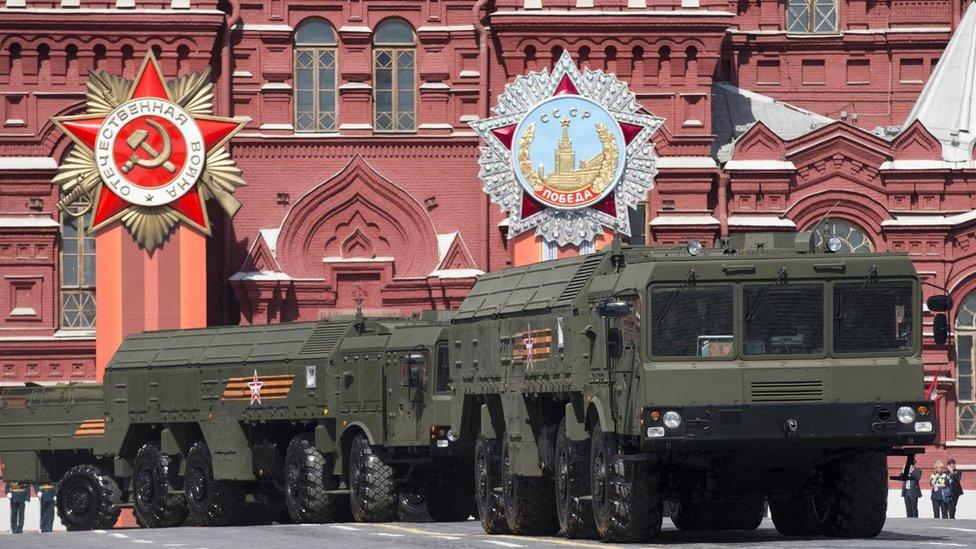Russia's missile deployment in Kaliningrad ups the stakes for Nato
- Published

The Iskander system is highly mobile
Russia's deployment of nuclear-capable missiles to its Kaliningrad exclave is setting off warning bells in the Baltics and at Nato.
This is not the first time that the Russians have deployed Iskander-M short-range ballistic missiles to Kaliningrad and it will not be the last. Indeed, some experts believe Russia's long-term plan is eventually to deploy the weapons permanently to the Russian enclave, sandwiched between Poland and Lithuania.
The Iskander-M system is relatively modern and was introduced into the Russian military in 2006. It is highly mobile - a pair of missiles are carried on a heavy-wheeled launcher. The missile is known as the SS-26 and code-named "Stone" by Nato. It is equipped with a variety of counter-measures to try to breach enemy defences. Fired from Kaliningrad, it can reach all of the Baltic republics and probably about two-thirds of Poland.
It is controversial on two counts - because of its range and because it is dual-capable. In other words, it can carry either a conventional or a nuclear warhead. Armed with a nuclear weapon, its range of in excess of some 500km (300 miles) brings it into the scope of the Intermediate Nuclear Forces (INF) treaty of 1987 which effectively bans the development and deployment of such weapons.
The US already believes that Russia has breached this treaty in its development work, but the regular deployment of the Iskander probably marks another nail in the coffin of the web of arms control agreements inherited from the Cold War.
Russia stresses that this deployment is part of a routine exercise. But equally, in the past it has brandished the Iskander system as a response to Nato's plans to deploy anti-ballistic missile defences in Europe. Russia has made several threats to target countries deploying elements of any missile defence system with nuclear weapons. Indeed, Russia's nuclear doctrine has also been re-written to afford a greater and earlier role for nuclear weapons in any regional conflict.
Poland and Estonia have both expressed concern at this latest deployment. The Chief of Staff of the Estonian Defence Forces, Lt Gen Riho Terras, sees the Iskander as part of a long-term Russian desire "to bring the Baltic Sea and the passages leading to it more and more under its control, and to control it much as it does the Black Sea".

Kaliningrad facts

Koenigsberg, as the city of Kaliningrad was once known, was founded by Teutonic knights in the 13th Century. It was once the capital of Prussia
Annexed by Russia from Germany after WWII. Germans fled or were expelled
It is more than 300km away from Russia, which can only be reached through an EU country
It houses the Russian Baltic Fleet and is the country's only ice-free European port
The philosopher Immanuel Kant spent all his life in the city and died there in 1804

This is all part of a developing Russian strategy of what Nato characterises as an "anti-access and area denial": deploying weapons systems and sensors with ever-longer range (or, in the case of Kaliningrad, to a location where even relatively short-range will do) to push Nato forces away from the area.
Russia's long-range radars and air defence systems in Syria, for example, reach well out into the Mediterranean and into Turkish air space. The Estonian general's comments about the Black Sea are timely, since many Nato experts fear that it is fast becoming, in effect, a Russian-controlled lake.
The view from Moscow
Seen from Moscow, however, the picture is very different. Russia has watched Nato expand its membership ever closer to Russian borders. Countries like the Baltic republics, whose territory was once part of the Soviet Union, are now active Nato members. It is a trend that Russian President Vladimir Putin - who sees the collapse of Soviet power as a major tragedy - will neither condone nor forget.
Nato is now reinforcing its military presence in the Baltics and Poland in response to Russia's growing assertiveness in the wake of its annexation of Crimea from Ukraine and its involvement in the fighting in eastern Ukraine. This again provides probably another motive for the deployment of the Iskander missiles.
Of course the debate has an element of the chicken and the egg. Where did the cycle of escalation actually begin? For Russia it is the original sin of Nato expansion, now worsened by ballistic missile defence and Nato military deployments (albeit very small) eastwards. For Nato it is Russian resentment, nuclear threats, and above all, its invasion and annexation of part of a sovereign country - Ukraine.

Kaliningrad borders both Poland and Lithuania, putting Russian missiles within range of Nato countries
Russia's deployment of the Iskander serves multiple strategic purposes beyond the purely military. It is intended to remind the Western public - and particularly those in the Baltic republics (Lithuania has elections this weekend) - of the nuclear stakes in facing up to Moscow.
It is part of the signalling in a wider information war between Russia and Nato, where Moscow seeks to divide the Atlantic alliance and to secure for itself the ability to do as it pleases in what it sees as its near-abroad. Thus Russian-backed forces control parts of Georgia; Russia has annexed Crimea and backs pro-Russian militias in eastern Ukraine.
The problem for Nato is that the Baltic republics, whilst once Soviet territory, are now firmly within the Western camp. It has to draw clear lines to confront Moscow's influence while trying to avoid escalating any crisis further.